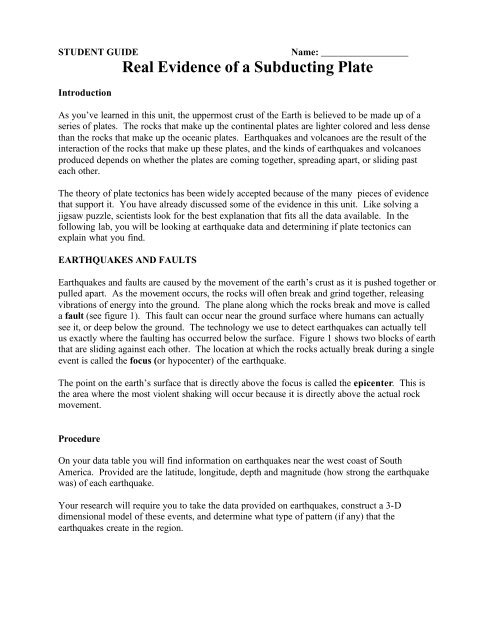Real Evidence of a Subducting Plate - Geological Society of America
Real Evidence of a Subducting Plate - Geological Society of America
Real Evidence of a Subducting Plate - Geological Society of America
You also want an ePaper? Increase the reach of your titles
YUMPU automatically turns print PDFs into web optimized ePapers that Google loves.
STUDENT GUIDE Name: __________________<br />
<strong>Real</strong> <strong>Evidence</strong> <strong>of</strong> a <strong>Subducting</strong> <strong>Plate</strong><br />
Introduction<br />
As you’ve learned in this unit, the uppermost crust <strong>of</strong> the Earth is believed to be made up <strong>of</strong> a<br />
series <strong>of</strong> plates. The rocks that make up the continental plates are lighter colored and less dense<br />
than the rocks that make up the oceanic plates. Earthquakes and volcanoes are the result <strong>of</strong> the<br />
interaction <strong>of</strong> the rocks that make up these plates, and the kinds <strong>of</strong> earthquakes and volcanoes<br />
produced depends on whether the plates are coming together, spreading apart, or sliding past<br />
each other.<br />
The theory <strong>of</strong> plate tectonics has been widely accepted because <strong>of</strong> the many pieces <strong>of</strong> evidence<br />
that support it. You have already discussed some <strong>of</strong> the evidence in this unit. Like solving a<br />
jigsaw puzzle, scientists look for the best explanation that fits all the data available. In the<br />
following lab, you will be looking at earthquake data and determining if plate tectonics can<br />
explain what you find.<br />
EARTHQUAKES AND FAULTS<br />
Earthquakes and faults are caused by the movement <strong>of</strong> the earth’s crust as it is pushed together or<br />
pulled apart. As the movement occurs, the rocks will <strong>of</strong>ten break and grind together, releasing<br />
vibrations <strong>of</strong> energy into the ground. The plane along which the rocks break and move is called<br />
a fault (see figure 1). This fault can occur near the ground surface where humans can actually<br />
see it, or deep below the ground. The technology we use to detect earthquakes can actually tell<br />
us exactly where the faulting has occurred below the surface. Figure 1 shows two blocks <strong>of</strong> earth<br />
that are sliding against each other. The location at which the rocks actually break during a single<br />
event is called the focus (or hypocenter) <strong>of</strong> the earthquake.<br />
The point on the earth’s surface that is directly above the focus is called the epicenter. This is<br />
the area where the most violent shaking will occur because it is directly above the actual rock<br />
movement.<br />
Procedure<br />
On your data table you will find information on earthquakes near the west coast <strong>of</strong> South<br />
<strong>America</strong>. Provided are the latitude, longitude, depth and magnitude (how strong the earthquake<br />
was) <strong>of</strong> each earthquake.<br />
Your research will require you to take the data provided on earthquakes, construct a 3-D<br />
dimensional model <strong>of</strong> these events, and determine what type <strong>of</strong> pattern (if any) that the<br />
earthquakes create in the region.
















